technical specifications FIAT DUCATO 2012 Owner handbook (in English)
[x] Cancel search | Manufacturer: FIAT, Model Year: 2012, Model line: DUCATO, Model: FIAT DUCATO 2012Pages: 287, PDF Size: 4.5 MB
Page 218 of 287
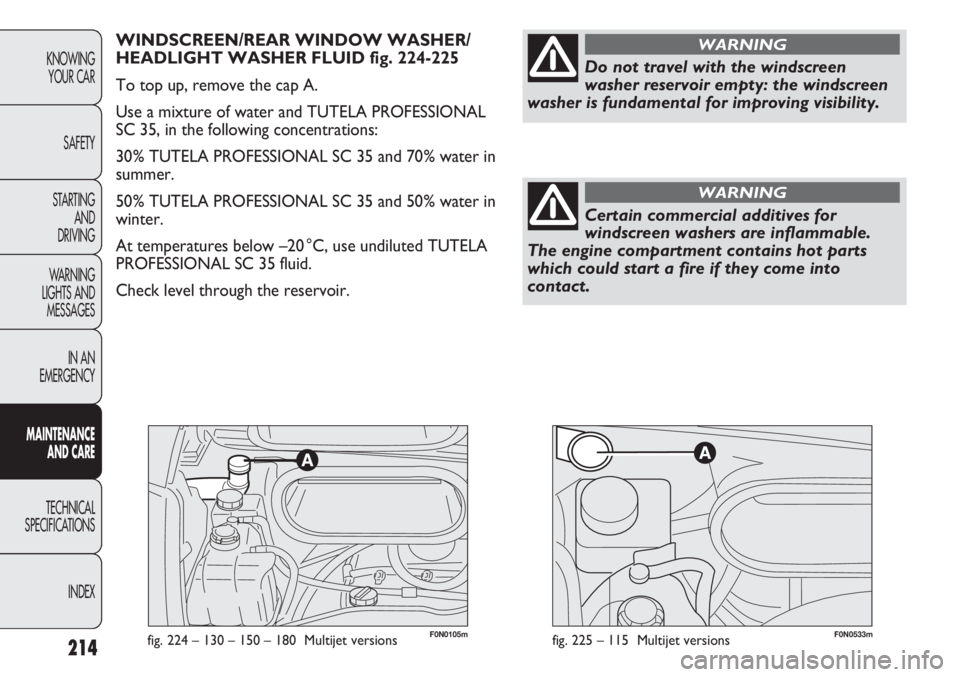
F0N0105mfig. 224 – 130 – 150 – 180 Multijet versions214
KNOWING
YOUR CAR
SAFETY
STARTING
AND
DRIVING
WARNING
LIGHTS AND
MESSAGES
IN AN
EMERGENCY
MAINTENANCE
AND CARE
TECHNICAL
SPECIFICATIONS
INDEX
WINDSCREEN/REAR WINDOW WASHER/
HEADLIGHT WASHER FLUID fig. 224-225
To top up, remove the cap A.
Use a mixture of water and TUTELA PROFESSIONAL
SC 35, in the following concentrations:
30% TUTELA PROFESSIONAL SC 35 and 70% water in
summer.
50% TUTELA PROFESSIONAL SC 35 and 50% water in
winter.
At temperatures below –20 °C, use undiluted TUTELA
PROFESSIONAL SC 35 fluid.
Check level through the reservoir.
Do not travel with the windscreen
washer reservoir empty: the windscreen
washer is fundamental for improving visibility.
WARNING
Certain commercial additives for
windscreen washers are inflammable.
The engine compartment contains hot parts
which could start a fire if they come into
contact.
WARNING
F0N0533mfig. 225 – 115 Multijet versions
Page 219 of 287
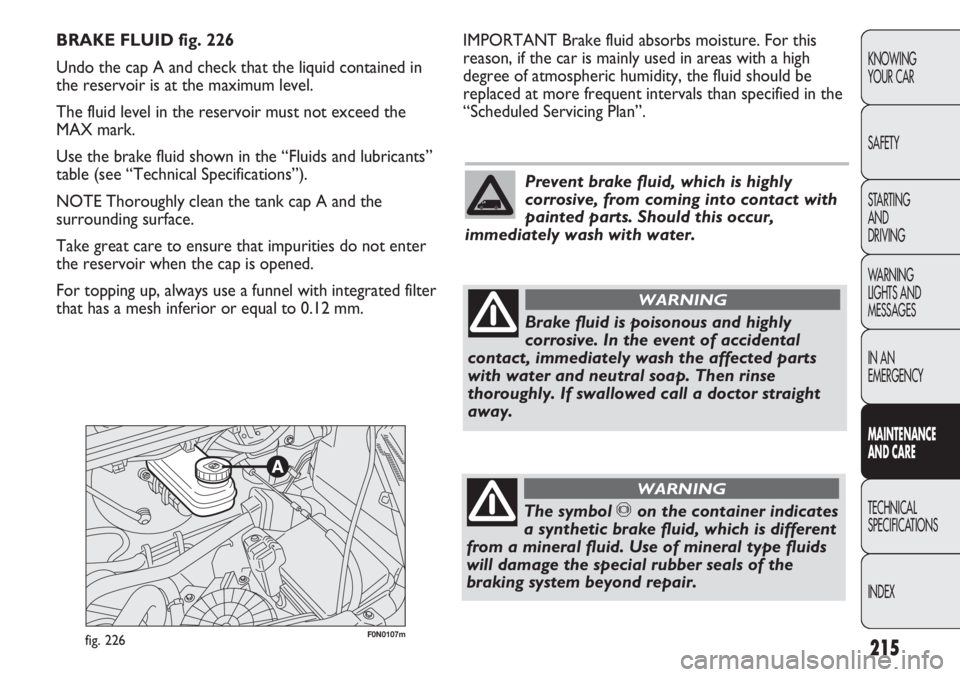
215
KNOWING
YOUR CAR
SAFETY
STARTING
AND
DRIVING
WARNING
LIGHTS AND
MESSAGES
IN AN
EMERGENCY
MAINTENANCE
AND CARE
TECHNICAL
SPECIFICATIONS
INDEX
F0N0107mfig. 226
IMPORTANT Brake fluid absorbs moisture. For this
reason, if the car is mainly used in areas with a high
degree of atmospheric humidity, the fluid should be
replaced at more frequent intervals than specified in the
“Scheduled Servicing Plan”. BRAKE FLUID fig. 226
Undo the cap A and check that the liquid contained in
the reservoir is at the maximum level.
The fluid level in the reservoir must not exceed the
MAX mark.
Use the brake fluid shown in the “Fluids and lubricants”
table (see “Technical Specifications”).
NOTE Thoroughly clean the tank cap A and the
surrounding surface.
Take great care to ensure that impurities do not enter
the reservoir when the cap is opened.
For topping up, always use a funnel with integrated filter
that has a mesh inferior or equal to 0.12 mm.
Prevent brake fluid, which is highly
corrosive, from coming into contact with
painted parts. Should this occur,
immediately wash with water.
Brake fluid is poisonous and highly
corrosive. In the event of accidental
contact, immediately wash the affected parts
with water and neutral soap. Then rinse
thoroughly. If swallowed call a doctor straight
away.
WARNING
The symbol πon the container indicates
a synthetic brake fluid, which is different
from a mineral fluid. Use of mineral type fluids
will damage the special rubber seals of the
braking system beyond repair.
WARNING
Page 220 of 287
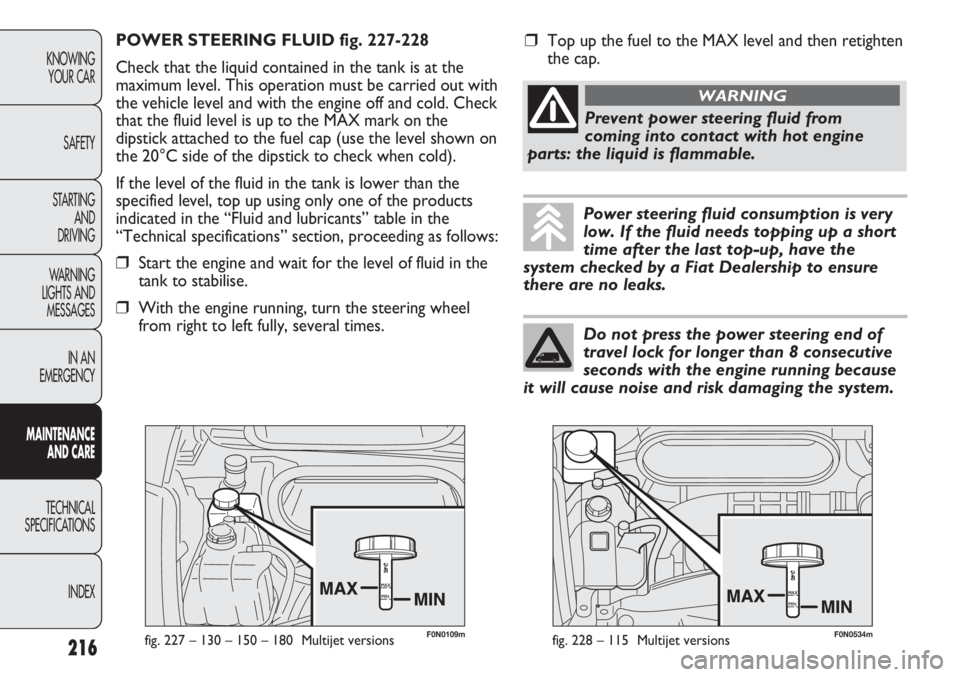
F0N0109mfig. 227 – 130 – 150 – 180 Multijet versions
POWER STEERING FLUID fig. 227-228
Check that the liquid contained in the tank is at the
maximum level. This operation must be carried out with
the vehicle level and with the engine off and cold. Check
that the fluid level is up to the MAX mark on the
dipstick attached to the fuel cap (use the level shown on
the 20°C side of the dipstick to check when cold).
If the level of the fluid in the tank is lower than the
specified level, top up using only one of the products
indicated in the “Fluid and lubricants” table in the
“Technical specifications” section, proceeding as follows:
❒Start the engine and wait for the level of fluid in the
tank to stabilise.
❒With the engine running, turn the steering wheel
from right to left fully, several times.
216
KNOWING
YOUR CAR
SAFETY
STARTING
AND
DRIVING
WARNING
LIGHTS AND
MESSAGES
IN AN
EMERGENCY
MAINTENANCE
AND CARE
TECHNICAL
SPECIFICATIONS
INDEX
Power steering fluid consumption is very
low. If the fluid needs topping up a short
time after the last top-up, have the
system checked by a Fiat Dealership to ensure
there are no leaks.
Do not press the power steering end of
travel lock for longer than 8 consecutive
seconds with the engine running because
it will cause noise and risk damaging the system.
❒Top up the fuel to the MAX level and then retighten
the cap.
Prevent power steering fluid from
coming into contact with hot engine
parts: the liquid is flammable.
WARNING
F0N0534mfig. 228 – 115 Multijet versions
Page 221 of 287
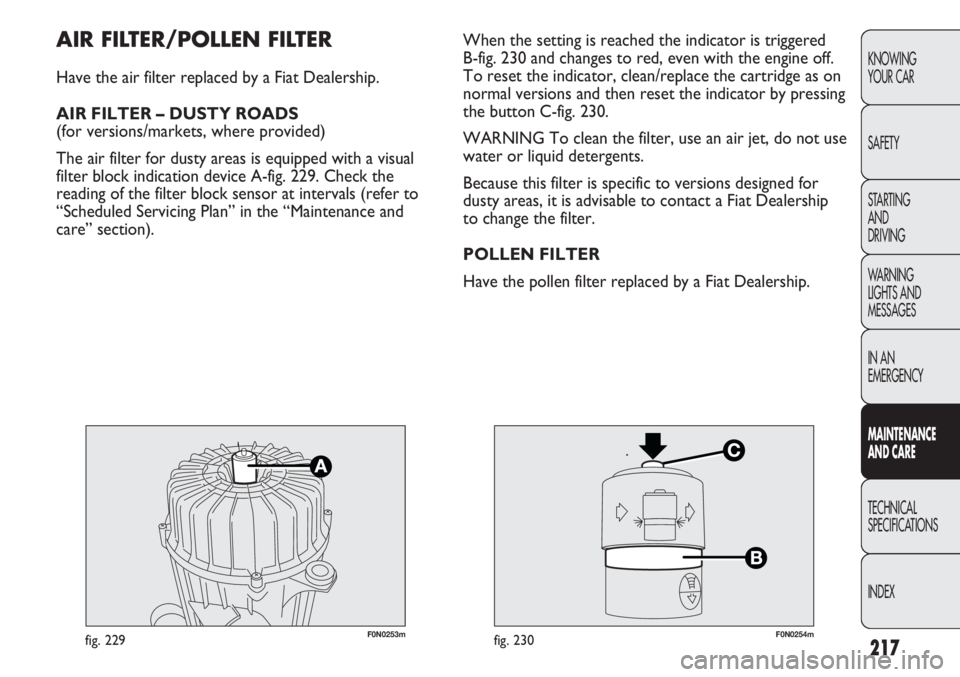
217
KNOWING
YOUR CAR
SAFETY
STARTING
AND
DRIVING
WARNING
LIGHTS AND
MESSAGES
IN AN
EMERGENCY
MAINTENANCE
AND CARE
TECHNICAL
SPECIFICATIONS
INDEX
F0N0253mfig. 229F0N0254mfig. 230
When the setting is reached the indicator is triggered
B-fig. 230 and changes to red, even with the engine off.
To reset the indicator, clean/replace the cartridge as on
normal versions and then reset the indicator by pressing
the button C-fig. 230.
WARNING To clean the filter, use an air jet, do not use
water or liquid detergents.
Because this filter is specific to versions designed for
dusty areas, it is advisable to contact a Fiat Dealership
to change the filter.
POLLEN FILTER
Have the pollen filter replaced by a Fiat Dealership.AIR FILTER/POLLEN FILTER
Have the air filter replaced by a Fiat Dealership.
AIR FILTER – DUSTY ROADS
(for versions/markets, where provided)
The air filter for dusty areas is equipped with a visual
filter block indication device A-fig. 229. Check the
reading of the filter block sensor at intervals (refer to
“Scheduled Servicing Plan” in the “Maintenance and
care” section).
Page 222 of 287
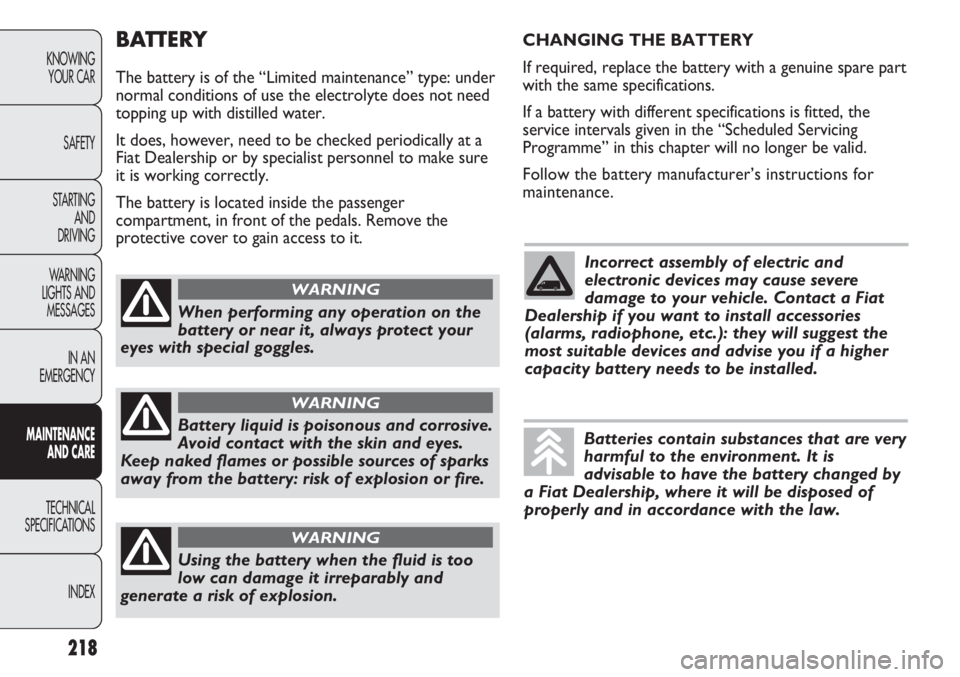
BATTERY
The battery is of the “Limited maintenance” type: under
normal conditions of use the electrolyte does not need
topping up with distilled water.
It does, however, need to be checked periodically at a
Fiat Dealership or by specialist personnel to make sure
it is working correctly.
The battery is located inside the passenger
compartment, in front of the pedals. Remove the
protective cover to gain access to it.
218
KNOWING
YOUR CAR
SAFETY
STARTING
AND
DRIVING
WARNING
LIGHTS AND
MESSAGES
IN AN
EMERGENCY
MAINTENANCE
AND CARE
TECHNICAL
SPECIFICATIONS
INDEX
When performing any operation on the
battery or near it, always protect your
eyes with special goggles.
WARNING
Battery liquid is poisonous and corrosive.
Avoid contact with the skin and eyes.
Keep naked flames or possible sources of sparks
away from the battery: risk of explosion or fire.
WARNING
Using the battery when the fluid is too
low can damage it irreparably and
generate a risk of explosion.
WARNING
CHANGING THE BATTERY
If required, replace the battery with a genuine spare part
with the same specifications.
If a battery with different specifications is fitted, the
service intervals given in the “Scheduled Servicing
Programme” in this chapter will no longer be valid.
Follow the battery manufacturer’s instructions for
maintenance.
Incorrect assembly of electric and
electronic devices may cause severe
damage to your vehicle. Contact a Fiat
Dealership if you want to install accessories
(alarms, radiophone, etc.): they will suggest the
most suitable devices and advise you if a higher
capacity battery needs to be installed.
Batteries contain substances that are very
harmful to the environment. It is
advisable to have the battery changed by
a Fiat Dealership, where it will be disposed of
properly and in accordance with the law.
Page 223 of 287
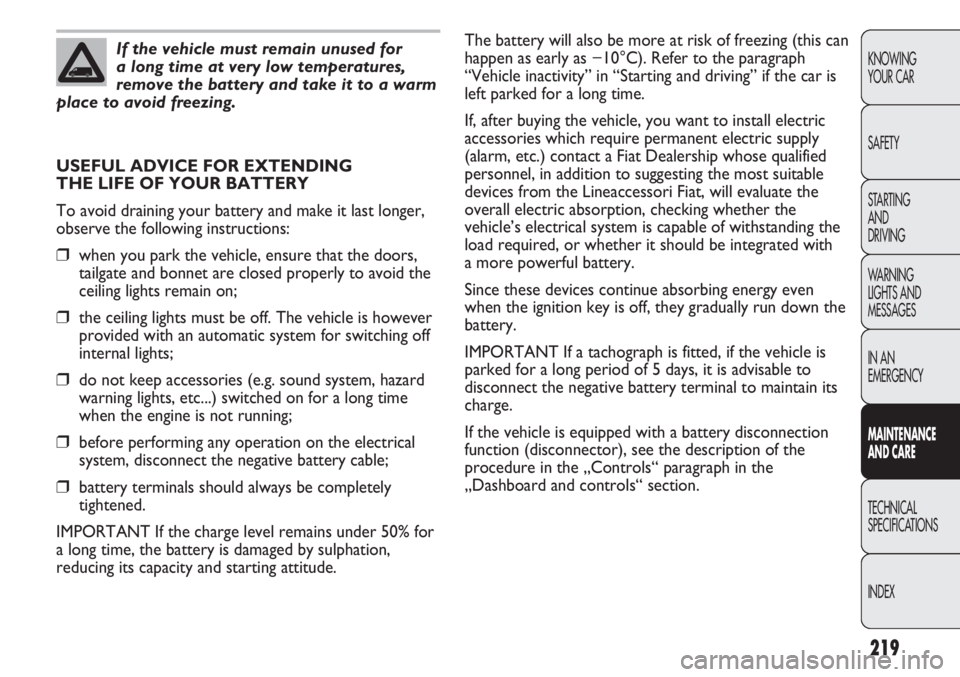
219
KNOWING
YOUR CAR
SAFETY
STARTING
AND
DRIVING
WARNING
LIGHTS AND
MESSAGES
IN AN
EMERGENCY
MAINTENANCE
AND CARE
TECHNICAL
SPECIFICATIONS
INDEX
If the vehicle must remain unused for
a long time at very low temperatures,
remove the battery and take it to a warm
place to avoid freezing.
USEFUL ADVICE FOR EXTENDING
THE LIFE OF YOUR BATTERY
To avoid draining your battery and make it last longer,
observe the following instructions:
❒when you park the vehicle, ensure that the doors,
tailgate and bonnet are closed properly to avoid the
ceiling lights remain on;
❒the ceiling lights must be off. The vehicle is however
provided with an automatic system for switching off
internal lights;
❒do not keep accessories (e.g. sound system, hazard
warning lights, etc...) switched on for a long time
when the engine is not running;
❒before performing any operation on the electrical
system, disconnect the negative battery cable;
❒battery terminals should always be completely
tightened.
IMPORTANT If the charge level remains under 50% for
a long time, the battery is damaged by sulphation,
reducing its capacity and starting attitude.The battery will also be more at risk of freezing (this can
happen as early as −10°C). Refer to the paragraph
“Vehicle inactivity” in “Starting and driving” if the car is
left parked for a long time.
If, after buying the vehicle, you want to install electric
accessories which require permanent electric supply
(alarm, etc.) contact a Fiat Dealership whose qualified
personnel, in addition to suggesting the most suitable
devices from the Lineaccessori Fiat, will evaluate the
overall electric absorption, checking whether the
vehicle’s electrical system is capable of withstanding the
load required, or whether it should be integrated with
a more powerful battery.
Since these devices continue absorbing energy even
when the ignition key is off, they gradually run down the
battery.
IMPORTANT If a tachograph is fitted, if the vehicle is
parked for a long period of 5 days, it is advisable to
disconnect the negative battery terminal to maintain its
charge.
If the vehicle is equipped with a battery disconnection
function (disconnector), see the description of the
procedure in the „Controls“ paragraph in the
„Dashboard and controls“ section.
Page 224 of 287
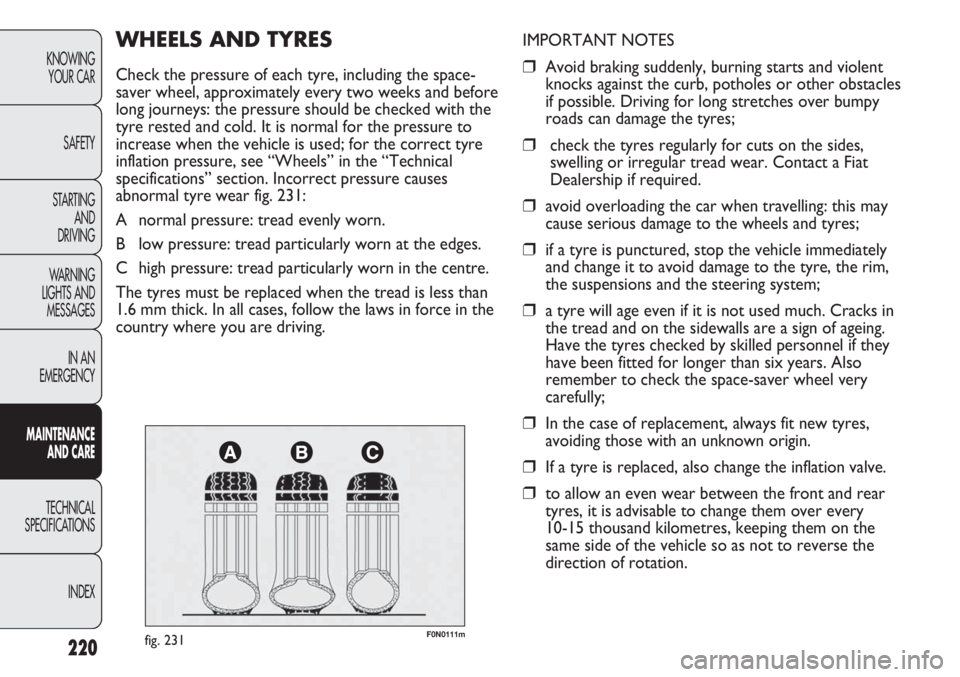
220
KNOWING
YOUR CAR
SAFETY
STARTING
AND
DRIVING
WARNING
LIGHTS AND
MESSAGES
IN AN
EMERGENCY
MAINTENANCE
AND CARE
TECHNICAL
SPECIFICATIONS
INDEX
F0N0111mfig. 231
IMPORTANT NOTES
❒Avoid braking suddenly, burning starts and violent
knocks against the curb, potholes or other obstacles
if possible. Driving for long stretches over bumpy
roads can damage the tyres;
❒check the tyres regularly for cuts on the sides,
swelling or irregular tread wear. Contact a Fiat
Dealership if required.
❒avoid overloading the car when travelling: this may
cause serious damage to the wheels and tyres;
❒if a tyre is punctured, stop the vehicle immediately
and change it to avoid damage to the tyre, the rim,
the suspensions and the steering system;
❒a tyre will age even if it is not used much. Cracks in
the tread and on the sidewalls are a sign of ageing.
Have the tyres checked by skilled personnel if they
have been fitted for longer than six years. Also
remember to check the space-saver wheel very
carefully;
❒In the case of replacement, always fit new tyres,
avoiding those with an unknown origin.
❒If a tyre is replaced, also change the inflation valve.
❒to allow an even wear between the front and rear
tyres, it is advisable to change them over every
10-15 thousand kilometres, keeping them on the
same side of the vehicle so as not to reverse the
direction of rotation.
WHEELS AND TYRES
Check the pressure of each tyre, including the space-
saver wheel, approximately every two weeks and before
long journeys: the pressure should be checked with the
tyre rested and cold. It is normal for the pressure to
increase when the vehicle is used; for the correct tyre
inflation pressure, see “Wheels” in the “Technical
specifications” section. Incorrect pressure causes
abnormal tyre wear fig. 231:
A normal pressure: tread evenly worn.
B low pressure: tread particularly worn at the edges.
C high pressure: tread particularly worn in the centre.
The tyres must be replaced when the tread is less than
1.6 mm thick. In all cases, follow the laws in force in the
country where you are driving.
Page 225 of 287
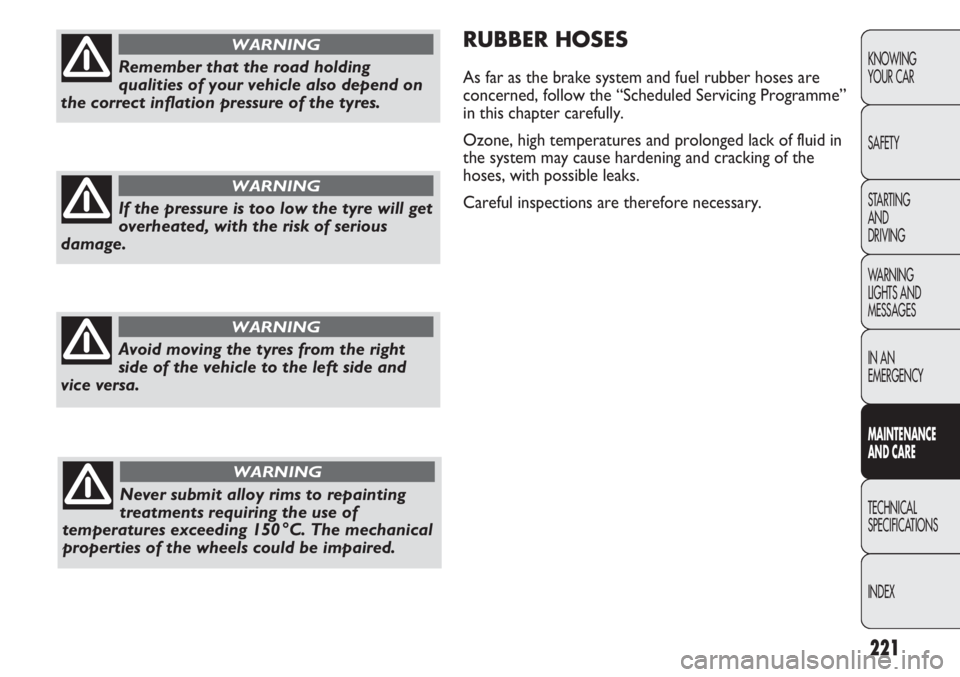
221
KNOWING
YOUR CAR
SAFETY
STARTING
AND
DRIVING
WARNING
LIGHTS AND
MESSAGES
IN AN
EMERGENCY
MAINTENANCE
AND CARE
TECHNICAL
SPECIFICATIONS
INDEX
RUBBER HOSES
As far as the brake system and fuel rubber hoses are
concerned, follow the “Scheduled Servicing Programme”
in this chapter carefully.
Ozone, high temperatures and prolonged lack of fluid in
the system may cause hardening and cracking of the
hoses, with possible leaks.
Careful inspections are therefore necessary.Remember that the road holding
qualities of your vehicle also depend on
the correct inflation pressure of the tyres.
WARNING
If the pressure is too low the tyre will get
overheated, with the risk of serious
damage.
WARNING
Avoid moving the tyres from the right
side of the vehicle to the left side and
vice versa.
WARNING
Never submit alloy rims to repainting
treatments requiring the use of
temperatures exceeding 150 °C. The mechanical
properties of the wheels could be impaired.
WARNING
Page 226 of 287
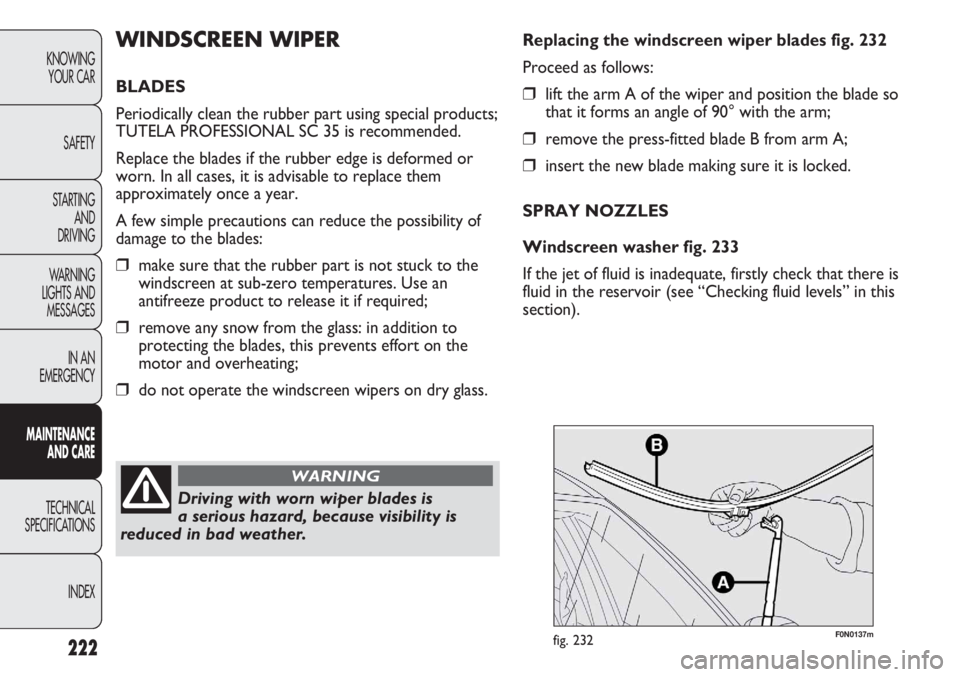
222
KNOWING
YOUR CAR
SAFETY
STARTING
AND
DRIVING
WARNING
LIGHTS AND
MESSAGES
IN AN
EMERGENCY
MAINTENANCE
AND CARE
TECHNICAL
SPECIFICATIONS
INDEX
F0N0137mfig. 232
Replacing the windscreen wiper blades fig. 232
Proceed as follows:
❒lift the arm A of the wiper and position the blade so
that it forms an angle of 90° with the arm;
❒remove the press-fitted blade B from arm A;
❒insert the new blade making sure it is locked.
SPRAY NOZZLES
Windscreen washer fig. 233
If the jet of fluid is inadequate, firstly check that there is
fluid in the reservoir (see “Checking fluid levels” in this
section).
WINDSCREEN WIPER
BLADES
Periodically clean the rubber part using special products;
TUTELA PROFESSIONAL SC 35 is recommended.
Replace the blades if the rubber edge is deformed or
worn. In all cases, it is advisable to replace them
approximately once a year.
A few simple precautions can reduce the possibility of
damage to the blades:
❒make sure that the rubber part is not stuck to the
windscreen at sub-zero temperatures. Use an
antifreeze product to release it if required;
❒remove any snow from the glass: in addition to
protecting the blades, this prevents effort on the
motor and overheating;
❒do not operate the windscreen wipers on dry glass.
Driving with worn wiper blades is
a serious hazard, because visibility is
reduced in bad weather.
WARNING
Page 227 of 287
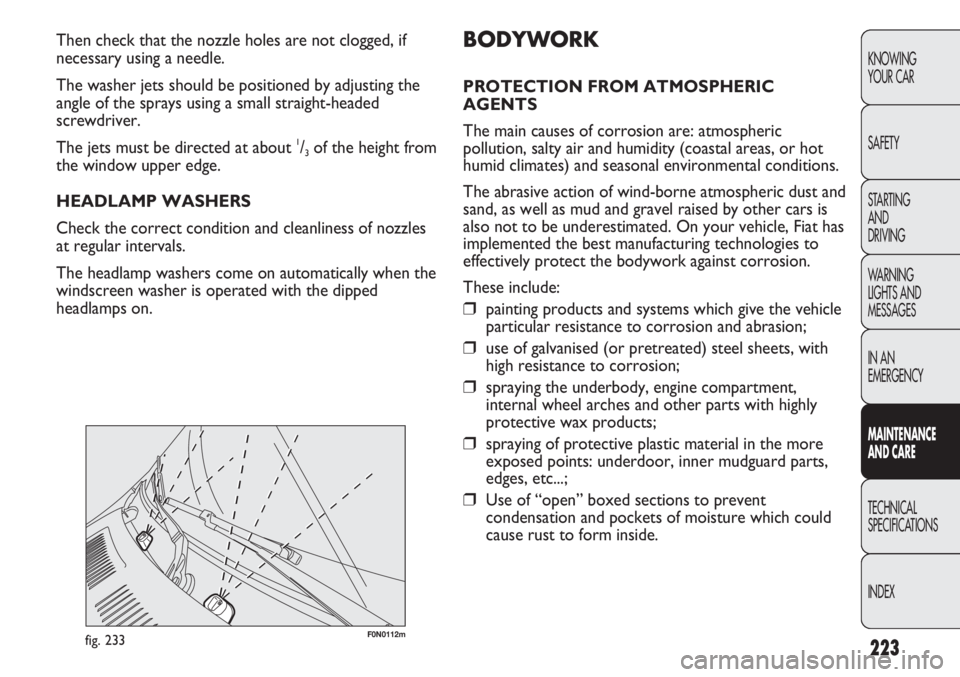
223
KNOWING
YOUR CAR
SAFETY
STARTING
AND
DRIVING
WARNING
LIGHTS AND
MESSAGES
IN AN
EMERGENCY
MAINTENANCE
AND CARE
TECHNICAL
SPECIFICATIONS
INDEX
F0N0112mfig. 233
BODYWORK
PROTECTION FROM ATMOSPHERIC
AGENTS
The main causes of corrosion are: atmospheric
pollution, salty air and humidity (coastal areas, or hot
humid climates) and seasonal environmental conditions.
The abrasive action of wind-borne atmospheric dust and
sand, as well as mud and gravel raised by other cars is
also not to be underestimated. On your vehicle, Fiat has
implemented the best manufacturing technologies to
effectively protect the bodywork against corrosion.
These include:
❒painting products and systems which give the vehicle
particular resistance to corrosion and abrasion;
❒use of galvanised (or pretreated) steel sheets, with
high resistance to corrosion;
❒spraying the underbody, engine compartment,
internal wheel arches and other parts with highly
protective wax products;
❒spraying of protective plastic material in the more
exposed points: underdoor, inner mudguard parts,
edges, etc...;
❒Use of “open” boxed sections to prevent
condensation and pockets of moisture which could
cause rust to form inside. Then check that the nozzle holes are not clogged, if
necessary using a needle.
The washer jets should be positioned by adjusting the
angle of the sprays using a small straight-headed
screwdriver.
The jets must be directed at about
1/3of the height from
the window upper edge.
HEADLAMP WASHERS
Check the correct condition and cleanliness of nozzles
at regular intervals.
The headlamp washers come on automatically when the
windscreen washer is operated with the dipped
headlamps on.